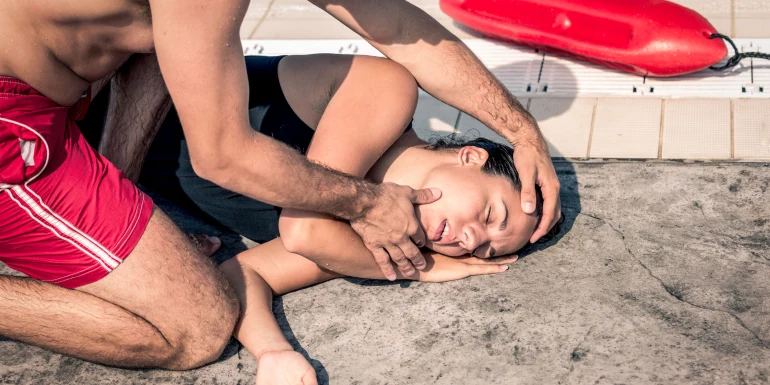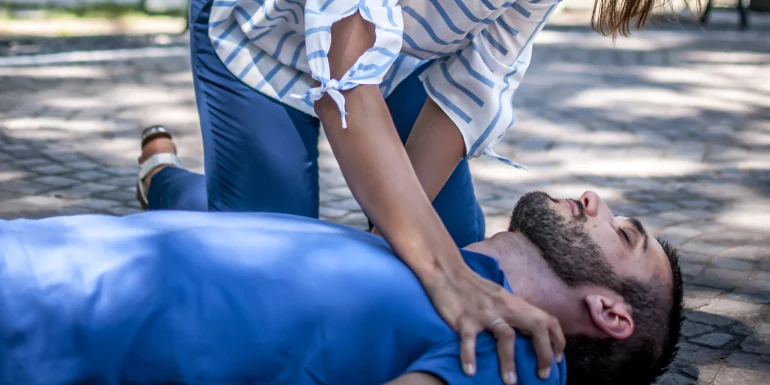
Emergencies from A to Z
An ABC of the most common emergencies – symptoms, triggers and the right thing to do in an emergency.
In a medical emergency, every second counts. People providing help must act swiftly but in a calm and considered way. The traffic light approach applies:
- Look
Try to get an overview of the situation: What happened? Who is involved? Who is affected? - Think
Make sure there is no risk for those rendering assistance, the affected individuals and others. - Act
Make sure the accident location is secure. Alert others by using an emergency triangle or your hazard warning lights. Call the emergency number 144 and provide first aid.
- 112: European emergency number
- 117: Police
- 118: Fire service
- 144: Ambulance
- 145: Toxicological centre
- 1414: Rega
In the «First Aid App» issued by the Swiss Red Cross (SRC), you will find life-saving information to use in an emergency.
From allergic reactions to strokes
Different emergencies require different responses. Find out the most important information about the most frequent types of emergency.
Symptoms
Rash, hives, redness of the skin and/or eyes, itching, swelling, runny nose, sneezing, coughing, shortness of breath, drop in blood pressure, loss of consciousness, vomiting, diarrhoea and dizziness
Causes
Foods, insect stings, medications, latex
Procedure
Call the emergency number 144, give a pre-filled adrenalin injection and/or administer emergency medication. Keep the person calm, put them in the recovery position if necessary. If the person is not breathing, start resuscitation immediately.
Prevention
People with known allergies (causing anaphylaxis) should always carry an adrenalin pen and emergency medication with them.
Further information
Symptoms
Difficulty breathing, difficulty speaking, coughing, wheezing , restlessness and anxiety, sweating
Causes
Upper respiratory tract infections, exposure to allergens (e.g. dust or pollen), cold air, physical strain, emotional excitement
Procedure
Keep the affected person sitting upright in a comfortable position, assist them in using their medication, keep them calm. If the attack persists: call the emergency number 144.
Please note
Asthma sufferers should be able to let you know if they are having an attack and what medication they need.
Procedure
Put pressure on the wound, rinse smaller wounds, do not remove foreign bodies. In the event of severe bleeding: call the emergency number 144
Please note
Avoid contact with other people’s blood wherever possible. Stop any bleeding.
Symptoms
Bruising, pain, swelling, unnatural position
Procedure
Keep injured body part still.
→ If the person is unable to move by themselves: call the emergency number 144
Symptoms
Reddening of the skin, feelings of warmth or heat, itching, pain or even complete numbness, blisters, charring, destruction of the skin
Causes
Sunburn, hot liquids, hot objects
Procedure
Cool the wound with water (about 20 degrees), dress the wound with a sterile dressing. If medical treatment is necessary, the wound must be covered with plastic (household cling film). Do not burst blisters.
→ For burns to the face, genitals, joints and large areas of the body (or if underlying tissue layer becomes visible): call the emergency number 144.
Symptoms
Shortness of breath, coughing, retching, wheezing, blue discolouration of the lips, loss of consciousness
Procedure
Always call the emergency number.
Encourage the person to cough, give five hard slaps between their shoulder blades as they bend forwards, perform five upper abdominal compressions (Heimlich manoeuvre). If the person stops breathing, start chest compression immediately.
Symptoms
Dizziness, loss of consciousness lasting several minutes, headache, confusion, nausea, blurred vision, memory loss
Procedure
Lie the affected person down, call the emergency number 144, watch for changes in condition.
Please note
In the event of concussion, there is a risk of increased pressure on the brain.
Symptoms
Symptoms can vary widely: feelings of hunger, cramps, clammy skin, profuse sweating, drowsiness, weakness, sudden loss of consciousness
Causes
Blood sugar level too low (hypoglycaemia); blood sugar level too high (hyperglycaemia)
Procedure
- Hypoglycaemia: eat some fast-acting sugar (e.g. dextrose, fruit juice).
- Hyperglycaemia: drink plenty of water, inject the amount of insulin previously agreed with a doctor
→ In the event of loss of consciousness or shortness of breath: call the emergency number 144
Prevention
Check blood sugar levels regularly.
Symptoms
Open, staring, empty or rolling eyes, convulsions, impaired movement or consciousness
Procedure
Do not restrain the affected person. Do not attempt to intervene in the seizure. Place a blanket under their head to reduce the risk of injury. Place the affected person in the recovery position.
→ If they have no prior history of seizures or if the attack is unusually severe or long-lasting: call the emergency number 144
Please note
Some people may wear or carry a specific item to identify themselves and their particular disorder (an ID, bracelet or chain).
Symptoms
- Men: shortness of breath and anxiety, sweating, sharp/burning pain in the chest, pain in shoulders and arms, regardless of movement
- Women: jaw pain, pressure and tightness in the chest, shortness of breath, nausea, vomiting, upper abdominal pain
Causes
Deposits and blockages in the coronary arteries that affect the blood supply to the heart muscle
Procedure
Call the emergency number 144, avoid any physical exertion, elevate the upper body, adopt a comfortable position. Use personal emergency medication such as nitroglycerin spray. In the event of cardiac arrest (person is no longer responding or breathing), start chest compression immediately or use a defibrillator.
Symptoms
Severe headaches and dizziness, high fever, feelings of extreme thirst, rapid and weak pulse, drop in blood pressure, state of exhaustion, reduced consciousness or loss of consciousness
Causes
High ambient temperatures and humidity, loss of body fluids owing to intense physical activity
Procedure
Call the emergency number 144, move the affected person to a cooler location. Remove any tight-fitting clothing, open their clothing, put cool/damp cloths on their skin, fan them. Slowly give the person cool water to drink, keep their upper body in an upright position. If their blood pressure drops: lie them down and prop their legs up.
Symptoms
Shivering, cold/pale skin, rapid breathing, raised pulse, low body temperature
Causes
Low ambient temperature, wind, wetness, prolonged exposure to cold, exhaustion
Procedure
Call the emergency number 144, keep the affected person calm and warm them up slowly with a blanket or thermal foil sheet, warm drinks, high-energy food. Put on dry and warm clothes. Find a place to shelter that is out of the wind.
Symptoms
Nausea and vomiting, intoxication, drowsiness, coughing, breathing difficulties, loss of consciousness, abdominal cramps
Causes
Medications, chemicals, plants, stimulants and drugs
Procedure
Establish what has been taken, when, and how much. Call the toxicological information centre number 145.
→ In the event of loss of consciousness, shortness of breath or a possible suicide attempt: call the emergency number 144.
Please note
Do not induce vomiting.
Symptoms
Rapid pulse, low blood pressure, cold sweat, cool hands and legs, rapid breathing, restlessness or change in state of consciousness
Causes
Loss of fluid (bleeding, diarrhoea/vomiting), pulmonary embolism, heart attack, arrhythmia, allergies, blood poisoning and spinal cord injuries
Procedure
Lie the affected person down flat, treat any bleeding or injury, remove any shock triggers. Ensure that the person does not become hypothermic or overheated. Do not give them anything to eat or drink, call the emergency number 144.
Symptoms
- Insects: pain, swelling, bleeding
- Ticks: occasional rash
- Jellyfish: burning sensation, reddened skin
- Venomous snakes: pain, bite marks, swelling, nausea, vomiting, tingling, shock, coma, paralysis, blood-clotting disorder
Procedure
- Insects: remove the sting, wash/disinfect the wound, cool the area. If the person shows signs of allergic shock, call the emergency number 144.
- Ticks: remove with tweezers or tick remover tool, wash/disinfect the wound and apply disinfectant cream.
- Jellyfish: get the affected person out of the water, wash the area with vinegar and rinse with warm water. If the person shows signs of shortness of breath, call the emergency number 144.
- Snake: in the event of a bite by a venomous snake, call the emergency number 144 immediately, wash and disinfect the wound, remove any jewellery, avoid physical exertion, keep the affected area below the heart level and avoid moving.
- Other bite injuries: control the bleeding, rinse/disinfect the wound. Contact a doctor if you suspect you may have been exposed to rabies.
Symptoms
Pain, swelling, bruising, restrictions of movement
Causes
Abrupt movements, trips and falls, violent external impact
Procedure
Apply RICE rule, R: rest (keep still); I: ice (cool); C: compression (compression bandage); E: elevation
Please note
Strains affect muscles, sprains affect joints.
Symptoms
Hemiplegia (weakness of one side of the face, one arm and/or leg), sensitivity disorders (numbness), visual disorders (e.g. double vision), unclear, slurred speech, headaches (with cerebral haemorrhage), balance impairments, dizziness, difficulty finding the right words, impaired orientation and memory loss
Cause
Insufficient blood flow to the brain.
Procedure
FAST check → F (Face): Does the affected person have weakness on one side of their face? A (Arms): Can the person raise both arms? S (Speech): Can you understand what they are saying? T (Time): Call the emergency number 144 as quickly as possible.
If possible, lie the affected person down flat. Do not give them anything to eat or drink, and do not administer any blood-thinning medication.
The list of symptoms provided here is not exhaustive.

André Roggli works as the interim head of «Education and Volunteer Management» at the Samaritans Switzerland – a rescue organisation of the Swiss Red Cross. In his position as a first aid training expert, he trains lay people from a wide variety of backgrounds. He regularly provides first aid services in organisations and at events. André Roggli gave the editorial team advice and input for this article.


Newsletter
Find out more about current health issues every month and get all the information you need about our attractive offers from all Helsana Group companies * delivered by e-mail to read whenever it suits you. Our newsletter is free of charge and you can sign up here:
We did not receive your information. Please try again later.
* The Helsana Group comprises Helsana Insurance Company Ltd, Helsana Supplementary Insurances Ltd and Helsana Accidents Ltd.